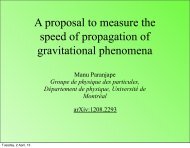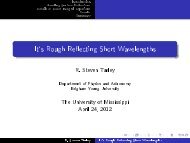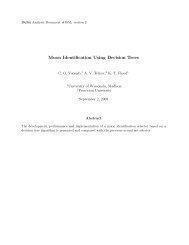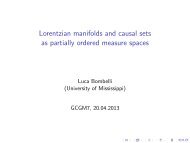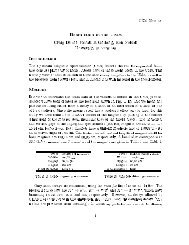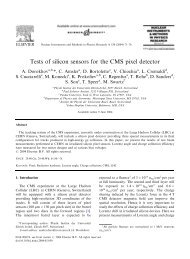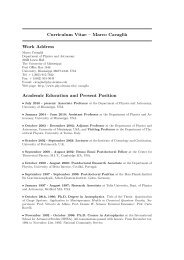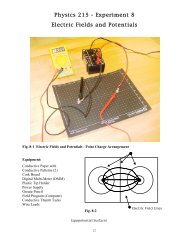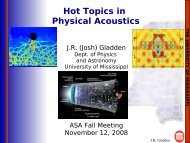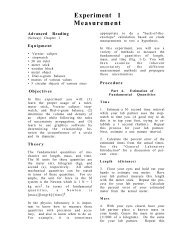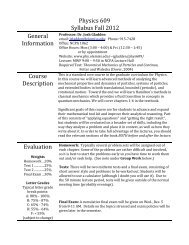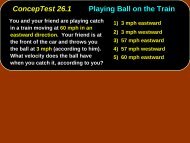Chap. 20 Conceptual Modules Giancoli
Chap. 20 Conceptual Modules Giancoli
Chap. 20 Conceptual Modules Giancoli
You also want an ePaper? Increase the reach of your titles
YUMPU automatically turns print PDFs into web optimized ePapers that Google loves.
ConcepTest PowerPoints<br />
<strong>Chap</strong>ter <strong>20</strong><br />
Physics: Principles with<br />
Applications, 6 th edition<br />
<strong>Giancoli</strong><br />
© <strong>20</strong>05 Pearson Prentice Hall<br />
This work is protected by United States copyright laws and is provided solely for<br />
the use of instructors in teaching their courses and assessing student learning.<br />
Dissemination or sale of any part of this work (including on the World Wide Web)<br />
will destroy the integrity of the work and is not permitted. The work and materials<br />
from it should never be made available to students except by instructors using<br />
the accompanying text in their classes. All recipients of this work are expected to<br />
abide by these restrictions and to honor the intended pedagogical purposes and<br />
the needs of other instructors who rely on these materials.
ConcepTest <strong>20</strong>.1a Magnetic Force I<br />
A positive charge enters a<br />
uniform magnetic field as<br />
shown. What is the direction<br />
of the magnetic force?<br />
1) out of the page<br />
2) into the page<br />
3) downwards<br />
4) to the right<br />
5) to the left<br />
x x x x x x<br />
v<br />
x x x x x x<br />
x x x x q<br />
x x
ConcepTest <strong>20</strong>.1a Magnetic Force I<br />
A positive charge enters a<br />
uniform magnetic field as<br />
shown. What is the direction<br />
of the magnetic force?<br />
1) out of the page<br />
2) into the page<br />
3) downwards<br />
4) to the right<br />
5) to the left<br />
Using the right-hand rule, you can<br />
see that the magnetic force is<br />
directed to the left. Remember<br />
that the magnetic force must be<br />
perpendicular to BOTH the B field<br />
and the velocity.<br />
x x x x x x<br />
v<br />
x x x x x x<br />
x x Fx<br />
x q<br />
x x
ConcepTest <strong>20</strong>.1b Magnetic Force II<br />
A positive charge enters a<br />
uniform magnetic field as<br />
shown. What is the direction<br />
of the magnetic force?<br />
1) out of the page<br />
2) into the page<br />
3) downwards<br />
4) upwards<br />
5) to the left<br />
x x x x x x<br />
x x x x x x<br />
q v<br />
x x x x x x
ConcepTest <strong>20</strong>.1b Magnetic Force II<br />
A positive charge enters a<br />
uniform magnetic field as<br />
shown. What is the direction<br />
of the magnetic force?<br />
1) out of the page<br />
2) into the page<br />
3) downwards<br />
4) upwards<br />
5) to the left<br />
Using the right-hand rule, you can<br />
see that the magnetic force is<br />
directed upwards. Remember<br />
that the magnetic force must be<br />
perpendicular to BOTH the B field<br />
and the velocity.<br />
x x x x x x<br />
F<br />
x x x x x x<br />
q v<br />
x x x x x x
ConcepTest <strong>20</strong>.1c Magnetic Force III<br />
A positive charge enters a<br />
uniform magnetic field as<br />
shown. What is the direction<br />
of the magnetic force?<br />
1) out of the page<br />
2) into the page<br />
3) zero<br />
4) to the right<br />
5) to the left<br />
→ → → → →<br />
→ → → v → →<br />
→ → → → →<br />
q<br />
→ → → → →
ConcepTest <strong>20</strong>.1c Magnetic Force III<br />
A positive charge enters a<br />
uniform magnetic field as<br />
shown. What is the direction<br />
of the magnetic force?<br />
1) out of the page<br />
2) into the page<br />
3) zero<br />
4) to the right<br />
5) to the left<br />
Using the right-hand rule, you can<br />
see that the magnetic force is<br />
directed into the page. Remember<br />
that the magnetic force must be<br />
perpendicular to BOTH the B field<br />
and the velocity.<br />
→ → → → →<br />
→ → → v → →<br />
→ → → → →<br />
F × q<br />
→ → → → →
↑ ↑ ↑ ↑ ↑ ↑ ↑<br />
↑<br />
ConcepTest <strong>20</strong>.1d Magnetic Force IV<br />
A positive charge enters a<br />
uniform magnetic field as<br />
shown. What is the direction<br />
of the magnetic force?<br />
1) out of the page<br />
2) into the page<br />
3) zero<br />
4) to the right<br />
5) to the left<br />
↑ ↑ ↑ ↑ ↑ ↑ ↑<br />
↑ v<br />
↑ ↑ ↑ ↑ q↑ ↑ ↑<br />
↑
↑ ↑ ↑ ↑ ↑ ↑ ↑<br />
↑<br />
ConcepTest <strong>20</strong>.1d Magnetic Force IV<br />
A positive charge enters a<br />
uniform magnetic field as<br />
shown. What is the direction<br />
of the magnetic force?<br />
1) out of the page<br />
2) into the page<br />
3) zero<br />
4) to the right<br />
5) to the left<br />
The charge is moving parallel to<br />
the magnetic field, so it does not<br />
experience any magnetic force.<br />
Remember that the magnetic force<br />
is given by: F = v B sin(θ ) .<br />
↑ ↑ ↑ ↑ ↑ ↑ ↑<br />
↑ v<br />
↑ ↑ ↑ ↑ q↑ ↑ ↑<br />
↑ F = 0
ConcepTest <strong>20</strong>.2 Atomic Beams<br />
A beam of atoms enters<br />
a magnetic field region.<br />
What path will the<br />
atoms follow?<br />
1<br />
x x x x x x x x x x x x<br />
x x x x x x x x x x x x<br />
x x x x x x x x x x x x<br />
x x x x x x x x x x x x<br />
x x x x x x x x x x x x<br />
4<br />
x x x x x x x x x x x x<br />
2<br />
3
ConcepTest <strong>20</strong>.2 Atomic Beams<br />
A beam of atoms enters<br />
a magnetic field region.<br />
What path will the<br />
atoms follow?<br />
1<br />
x x x x x x x x x x x x<br />
x x x x x x x x x x x x<br />
x x x x x x x x x x x x<br />
x x x x x x x x x x x x<br />
x x x x x x x x x x x x<br />
4<br />
x x x x x x x x x x x x<br />
2<br />
3<br />
Atoms are neutral objects whose net charge is zero.<br />
Thus they do not experience a magnetic force.<br />
Follow-up: What charge would follow path #3? What about path #1?
ConcepTest <strong>20</strong>.3 Magnetic Field<br />
A proton beam enters into a<br />
magnetic field region as shown<br />
below. What is the direction<br />
of the magnetic field B?<br />
1) + y<br />
2) – y<br />
3) + x<br />
4) + z (out of page)<br />
5) – z (into page)<br />
y<br />
x
ConcepTest <strong>20</strong>.3 Magnetic Field<br />
A proton beam enters into a<br />
magnetic field region as shown<br />
below. What is the direction<br />
of the magnetic field B?<br />
1) + y<br />
2) – y<br />
3) + x<br />
4) + z (out of page)<br />
5) – z (into page)<br />
The picture shows the force acting<br />
in the +y direction. Applying the<br />
right-hand rule leads to a B field<br />
that points into the page. The B<br />
field must be out of the plane<br />
because B ⊥ v and B ⊥ F.<br />
y<br />
x<br />
Follow-up: What would happen to a beam of atoms?
ConcepTest <strong>20</strong>.4a Mass Spectrometer I<br />
Two particles of the same mass<br />
enter a magnetic field with the<br />
x x x x x x x x x x x<br />
x<br />
x x x x x x x x x x x<br />
x<br />
same speed and follow the paths<br />
shown.<br />
x x x x x x x x x x x<br />
Which particle has the<br />
x<br />
bigger charge?<br />
x x x x x x x x x x x<br />
1 x 2<br />
3) both charges are equal x x x x x x x x x x x<br />
4) impossible to tell from the picture x<br />
x x x x x x x x x x x<br />
x
ConcepTest <strong>20</strong>.4a Mass Spectrometer I<br />
Two particles of the same mass<br />
According to this equation, the<br />
x x x x x x x x x x x<br />
x<br />
enter a magnetic field with the<br />
x x x x x x x x x x x<br />
x<br />
same speed and follow the paths<br />
shown.<br />
x x x x x x x x x x x<br />
Which particle has the<br />
x<br />
bigger charge?<br />
x x x x x x x x x x x<br />
1 x 2<br />
3) both charges are equal x x x x x x x x x x x<br />
4) impossible to tell from the picture x<br />
x x x x x x x x x x x<br />
x<br />
The relevant equation for us is:<br />
R =<br />
mv<br />
qB<br />
bigger the charge, the smaller the radius.<br />
Follow-up: What is the sign of the charges in the picture?
ConcepTest <strong>20</strong>.4b Mass Spectrometer II<br />
A proton enters a uniform<br />
magnetic field that is<br />
perpendicular to the<br />
proton’s velocity. What<br />
happens to the kinetic<br />
energy of the proton?<br />
1) it increases<br />
2) it decreases<br />
3) it stays the same<br />
4) depends on the velocity direction<br />
5) depends on the B field direction<br />
x x x x x x x x x x x<br />
x<br />
x x x x x x x x x x x<br />
x<br />
x x x x x x x x x x x<br />
x<br />
x x x x x x x x x x x<br />
x<br />
x x x x x x x x x x x
ConcepTest <strong>20</strong>.4b Mass Spectrometer II<br />
A proton enters a uniform<br />
magnetic field that is<br />
perpendicular to the<br />
proton’s velocity. What<br />
happens to the kinetic<br />
energy of the proton?<br />
1) it increases<br />
2) it decreases<br />
3) it stays the same<br />
4) depends on the velocity direction<br />
5) depends on the B field direction<br />
The velocity of the proton<br />
changes direction but the<br />
magnitude (speed) doesn’t<br />
change. Thus the kinetic<br />
energy stays the same.<br />
x x x x x x x x x x x<br />
x<br />
x x x x x x x x x x x<br />
x<br />
x x x x x x x x x x x<br />
x<br />
x x x x x x x x x x x<br />
x<br />
x x x x x x x x x x x
ConcepTest <strong>20</strong>.5 Velocity Selector<br />
What direction would a B field<br />
have to point for a beam of<br />
electrons moving to the right to<br />
go undeflected through a region<br />
where there is a uniform electric<br />
field pointing vertically upward?<br />
1) up (parallel to E )<br />
2) down (antiparallel to E )<br />
3) into the page<br />
4) out of the page<br />
5) impossible to accomplish<br />
E<br />
electrons<br />
B = ?<br />
v
ConcepTest <strong>20</strong>.5 Velocity Selector<br />
What direction would a B field<br />
have to point for a beam of<br />
electrons moving to the right to<br />
go undeflected through a region<br />
where there is a uniform electric<br />
field pointing vertically upward?<br />
1) up (parallel to E )<br />
2) down (antiparallel to E )<br />
3) into the page<br />
4) out of the page<br />
5) impossible to accomplish<br />
Without a B field, the electrons feel an<br />
electric force downwards. In order to<br />
compensate, the magnetic force has to<br />
point upwards. Using the right-hand<br />
rule and the fact that the electrons are<br />
negatively charged leads to a B field<br />
pointing out of the page.<br />
electrons<br />
B = ?<br />
v<br />
E
ConcepTest <strong>20</strong>.6a Magnetic Force on a Wire I<br />
A horizontal wire carries a current<br />
and is in a vertical magnetic field.<br />
What is the direction of the force<br />
on the wire?<br />
1) left<br />
2) right<br />
3) zero<br />
4) into the page<br />
5) out of the page<br />
I<br />
B
ConcepTest <strong>20</strong>.6a Magnetic Force on a Wire I<br />
A horizontal wire carries a current<br />
and is in a vertical magnetic field.<br />
What is the direction of the force on<br />
the wire?<br />
1) left<br />
2) right<br />
3) zero<br />
4) into the page<br />
5) out of the page<br />
Using the right-hand rule, we<br />
see that the magnetic force<br />
must point out of the page.<br />
Since F must be perpendicular<br />
to both I and B, you should<br />
realize that F cannot be in the<br />
plane of the page at all.<br />
I<br />
B
ConcepTest <strong>20</strong>.6b Magnetic Force on a Wire II<br />
A horizontal wire carries a current<br />
and is in a vertical magnetic field.<br />
What is the direction of the force<br />
on the wire?<br />
1) left<br />
2) right<br />
3) zero<br />
4) into the page<br />
5) out of the page<br />
I<br />
B
ConcepTest <strong>20</strong>.6b Magnetic Force on a Wire II<br />
A horizontal wire carries a current<br />
and is in a vertical magnetic field.<br />
What is the direction of the force on<br />
the wire?<br />
1) left<br />
2) right<br />
3) zero<br />
4) into the page<br />
5) out of the page<br />
I<br />
When the current is parallel to<br />
the magnetic field lines, the force<br />
on the wire is zero.<br />
B
ConcepTest <strong>20</strong>.7a Magnetic Force on a Loop I<br />
A rectangular current loop is<br />
in a uniform magnetic field.<br />
What is the direction of the<br />
net force on the loop?<br />
1) + x<br />
2) + y<br />
3) zero<br />
4) - x<br />
5) - y<br />
z<br />
B<br />
x<br />
y
ConcepTest <strong>20</strong>.7a Magnetic Force on a Loop I<br />
A rectangular current loop is<br />
in a uniform magnetic field.<br />
What is the direction of the<br />
net force on the loop?<br />
1) + x<br />
2) + y<br />
3) zero<br />
4) - x<br />
5) - y<br />
Using the right-hand rule, we find that<br />
each of the four wire segments will<br />
experience a force outwards from the<br />
center of the loop. Thus, the forces<br />
of the opposing segments cancel, so<br />
the net force is zero.<br />
z<br />
B<br />
x<br />
y
ConcepTest <strong>20</strong>.7b Magnetic Force on a Loop II<br />
If there is a current in<br />
the loop in the direction<br />
shown, the loop will:<br />
1) move up<br />
2) move down<br />
3) rotate clockwise<br />
4) rotate counterclockwise<br />
5) both rotate and move<br />
B field out of North<br />
B field into South<br />
N<br />
S<br />
S<br />
N
ConcepTest <strong>20</strong>.7b Magnetic Force on a Loop II<br />
If there is a current in<br />
the loop in the direction<br />
shown, the loop will:<br />
1) move up<br />
2) move down<br />
3) rotate clockwise<br />
4) rotate counterclockwise<br />
5) both rotate and move<br />
Look at the North Pole: here the<br />
magnetic field points to the right and<br />
the current points out of the page.<br />
The right-hand rule says that the force<br />
must point up. At the south pole, the<br />
same logic leads to a downward force.<br />
Thus the loop rotates clockwise.<br />
F<br />
N<br />
S<br />
F
ConcepTest <strong>20</strong>.8a Magnetic Field of a Wire I<br />
If the currents in these wires have<br />
the same magnitude, but opposite<br />
directions, what is the direction of<br />
the magnetic field at point P?<br />
1) direction 1<br />
2) direction 2<br />
3) direction 3<br />
4) direction 4<br />
5) the B field is zero<br />
4<br />
P<br />
1<br />
3<br />
2
ConcepTest <strong>20</strong>.8a Magnetic Field of a Wire I<br />
If the currents in these wires have<br />
the same magnitude, but opposite<br />
directions, what is the direction of<br />
the magnetic field at point P?<br />
Using the right-hand rule, we<br />
can sketch the B fields due<br />
to the two currents. Adding<br />
them up as vectors gives a<br />
total magnetic field pointing<br />
downward.<br />
1) direction 1<br />
2) direction 2<br />
3) direction 3<br />
4) direction 4<br />
5) the B field is zero<br />
4<br />
P<br />
1<br />
3<br />
2
ConcepTest <strong>20</strong>.8b Magnetic Field of a Wire II<br />
Each of the wires in the figures<br />
below carry the same current,<br />
either into or out of the page.<br />
In which case is the magnetic<br />
field at the center of the square<br />
greatest?<br />
1) arrangement 1<br />
2) arrangement 2<br />
3) arrangement 3<br />
4) same for all<br />
1 B=? 2 B=? 3<br />
B=?
ConcepTest <strong>20</strong>.8b Magnetic Field of a Wire II<br />
Each of the wires in the figures<br />
below carry the same current,<br />
either into or out of the page.<br />
In which case is the magnetic<br />
field at the center of the square<br />
greatest?<br />
1) arrangement 1<br />
2) arrangement 2<br />
3) arrangement 3<br />
4) same for all<br />
1 2 3
ConcepTest <strong>20</strong>.9a Field and Force I<br />
A positive charge moves parallel<br />
to a wire. If a current is suddenly<br />
turned on, which direction will the<br />
force act?<br />
1) + z (out of page)<br />
2) - z (into page)<br />
3) + x<br />
4) - x<br />
5) - y<br />
y<br />
+q<br />
I<br />
z<br />
x
ConcepTest <strong>20</strong>.9a Field and Force I<br />
A positive charge moves parallel<br />
to a wire. If a current is suddenly<br />
turned on, which direction will the<br />
force act?<br />
1) + z (out of page)<br />
2) - z (into page)<br />
3) + x<br />
4) - x<br />
5) - y<br />
Using the right-hand rule to determine the<br />
magnetic field produced by the wire, we<br />
find that at the position of the charge +q<br />
(to the left of the wire) the B field points<br />
out of the page. Applying the right-hand<br />
rule again for the magnetic force on the<br />
charge, we find that +q experiences a<br />
force in the +x direction.<br />
y<br />
z<br />
+q<br />
x<br />
I
ConcepTest <strong>20</strong>.9b Field and Force II<br />
Two straight wires run parallel to<br />
each other, each carrying a<br />
current in the direction shown<br />
below. The two wires experience<br />
a force in which direction?<br />
1) toward each other<br />
2) away from each other<br />
3) there is no force
ConcepTest <strong>20</strong>.9b Field and Force II<br />
Two straight wires run parallel to<br />
each other, each carrying a<br />
current in the direction shown<br />
below. The two wires experience<br />
a force in which direction?<br />
1) toward each other<br />
2) away from each other<br />
3) there is no force<br />
The current in each wire produces a magnetic<br />
field that is felt by the current of the other<br />
wire. Using the right-hand rule, we find that<br />
each wire experiences a force toward the<br />
other wire (i.e., an attractive force) when the<br />
currents are parallel (as shown).<br />
Follow-up: What happens when<br />
one of the currents is turned off?
ConcepTest <strong>20</strong>.10 Current Loop<br />
What is the direction of the<br />
magnetic field at the center<br />
(point P) of the square loop<br />
of current?<br />
1) left<br />
2) right<br />
3) zero<br />
4) into the page<br />
5) out of the page<br />
I<br />
P
ConcepTest <strong>20</strong>.10 Current Loop<br />
What is the direction of the<br />
magnetic field at the center<br />
(point P) of the square loop<br />
of current?<br />
1) left<br />
2) right<br />
3) zero<br />
4) into the page<br />
5) out of the page<br />
Use the right-hand rule for each<br />
wire segment to find that each<br />
segment has its B field pointing<br />
out of the page at point P.<br />
I<br />
P



